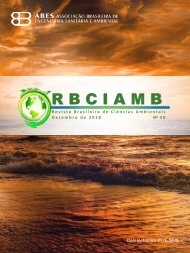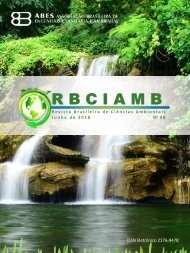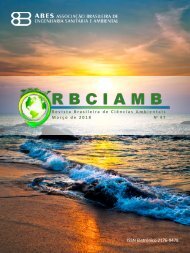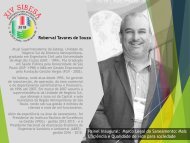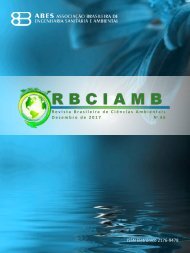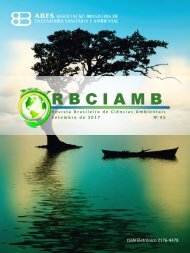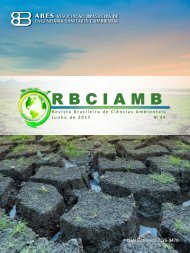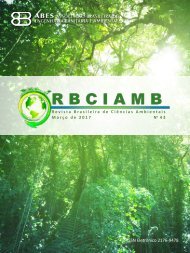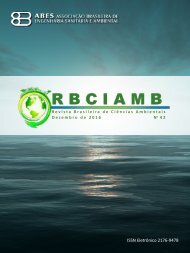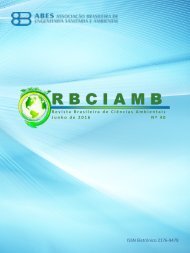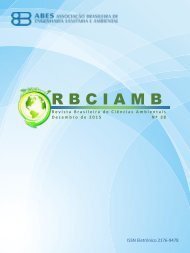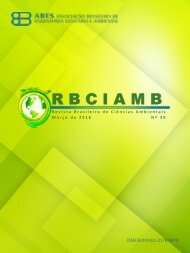EDIÇÃO 22 - Dezembro/11 - RBCIAMB
A Revista Brasileira de Ciências Ambientais – RBCIAMB - publica artigos completos de trabalhos científicos originais ou trabalhos de revisão com relevância para a área de Ciências Ambientais. A RBCIAMB prioriza artigos com perspectiva interdisciplinar. O foco central da revista é a discussão de problemáticas que se inscrevam na relação sociedade e natureza em sentido amplo, envolvendo aspectos ambientais em processos de desenvolvimento, tecnologias e conservação. A submissão dos trabalhos é de fluxo contínuo.
A Revista Brasileira de Ciências Ambientais – RBCIAMB - publica artigos completos de trabalhos científicos originais ou trabalhos de revisão com relevância para a área de Ciências Ambientais. A RBCIAMB prioriza artigos com perspectiva interdisciplinar. O foco central da revista é a discussão de problemáticas que se inscrevam na relação sociedade e natureza em sentido amplo, envolvendo aspectos ambientais em processos de desenvolvimento, tecnologias e conservação. A submissão dos trabalhos é de fluxo contínuo.
Create successful ePaper yourself
Turn your PDF publications into a flip-book with our unique Google optimized e-Paper software.
62Database and processing stages Based on the methodology of international policies on climate change and on the information in relation to Greenhouse Gas (GHG) emitted as a result of inadequate management with the use of fire in sugarcane pre-‐harvest (Saccharum spp.), in this case the state of Goiás -‐ period from 2005 to 2009, this article follows the calculations guidelines used in the first Greenhouse Gas Anthropogenic Emissions Inventory (MCT 2002), which adapted the methodology presented in the Fourth Module of the Intergovernmental Panel on Climate Change -‐ Reference Manual (IPCC, 1997). Attending to the last guideline suggested by the manual, which proposes the inclusion of a law to reduce GHGs, here follows Borja’s (BORJA, 2007) proposal, which considers the Decree Law No. 2.661/1998, paragraph IV which regulates the gradual reduction of fire use in a quarter (minimum) of the mechanized agricultural area, every 5 years, not exceeding the limit of 2020. With such methodological grounds, all the sugarcane production in Goiás is considered to be done in mechanized areas and due to this two different scenarios are proposed: 1) with 100% use of fire and with gradual reduction (from 2005 to 2009 -‐ study period -‐ with 50% reduction). Finally, it is also analyzed the data from CANASAT Project (2010) sugarcane plantations, based on satellite data (Landsat-‐TM), to identify and track the spatial distribution of sugarcane plantations in the State of Goiás from 2005 to 2009. This data was analyzed together with images of fire scars, generated WIST NASA (2010) by the MODIS (Product MCD451A) sensor, pointing out the burning areas in the sugarcane plantations in Goiás between 2005 to 2009. From this data it was recalculated the actual emission of anthropogenic gases based on the Inventory Methodology (BORJA, 2007; MCT, 2002). RESULTS AND DISCUSSION The current warming in the international demand for ethanol from sugarcane was motivated by replacing fossil fuels (from the Kyoto Protocol) and too by the increase in sale of flex fuel cars (ie. biofuels). This scenario has leveraged the sugarcane sector in Goiás, making it one of the most promising activities of the agribusiness in the region. Over the past five years the production of sugarcane in the state of Goiás has nearly tripled, going from 15.642.125 tons in 2005 to 44.064.470 tons in 2009 (CANASAT, 2010). Despite the good productivity ( average of 80 tons / ha – 2006 to 2009), the productive expansion basis in this period happened due to the increase by 260% in the planted areas, going from 200 thousand hectares in 2005 to over 520 thousand hectares in 2009 (SEPLAN/SEPLIN, 2010). With this productive supply, Goiás became the fourth largest sugarcane producer in Brazil and the second largest ethanol producer in the country (SIFAEG, 2010). Considering this productive scenario and assuming this total sugarcane production disposition at fire in the pre-‐harvest, the emission annual average (BORJA, 2007; MCT, 2002) is estimated, in Gig gram (Gg = 10 9 ), of methane (CH 4 ), nitrous oxide (N 2 O), carbon monoxide (CO) and nitrogen oxides (NOx) from 2005 to 2009 in, respectively, <strong>11</strong>.97, 251.47, 0.59 and 21.42. According to this 700Box & Whisker Plot: C-Coeq600500C-Coeq400300200100Uso of fireReduction in the use of fireTypeMeanMean±SEMean±1,96*SEFig. 2 -‐ Carbon dioxide equivalent emission in accordance with the use of burnings during the pre-‐harvest and with the reduction of burnings.Revista Brasileira de Ciências Ambientais – Número <strong>22</strong> – dezembro de 20<strong>11</strong> 62 ISSN Impresso 1808-‐4524 / ISSN Eletrônico: 2176-‐9478





